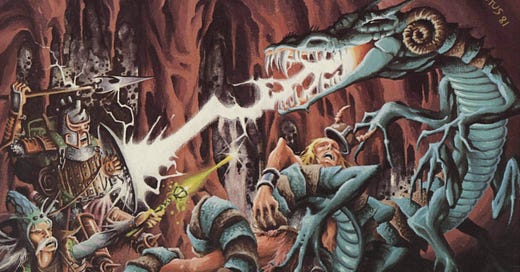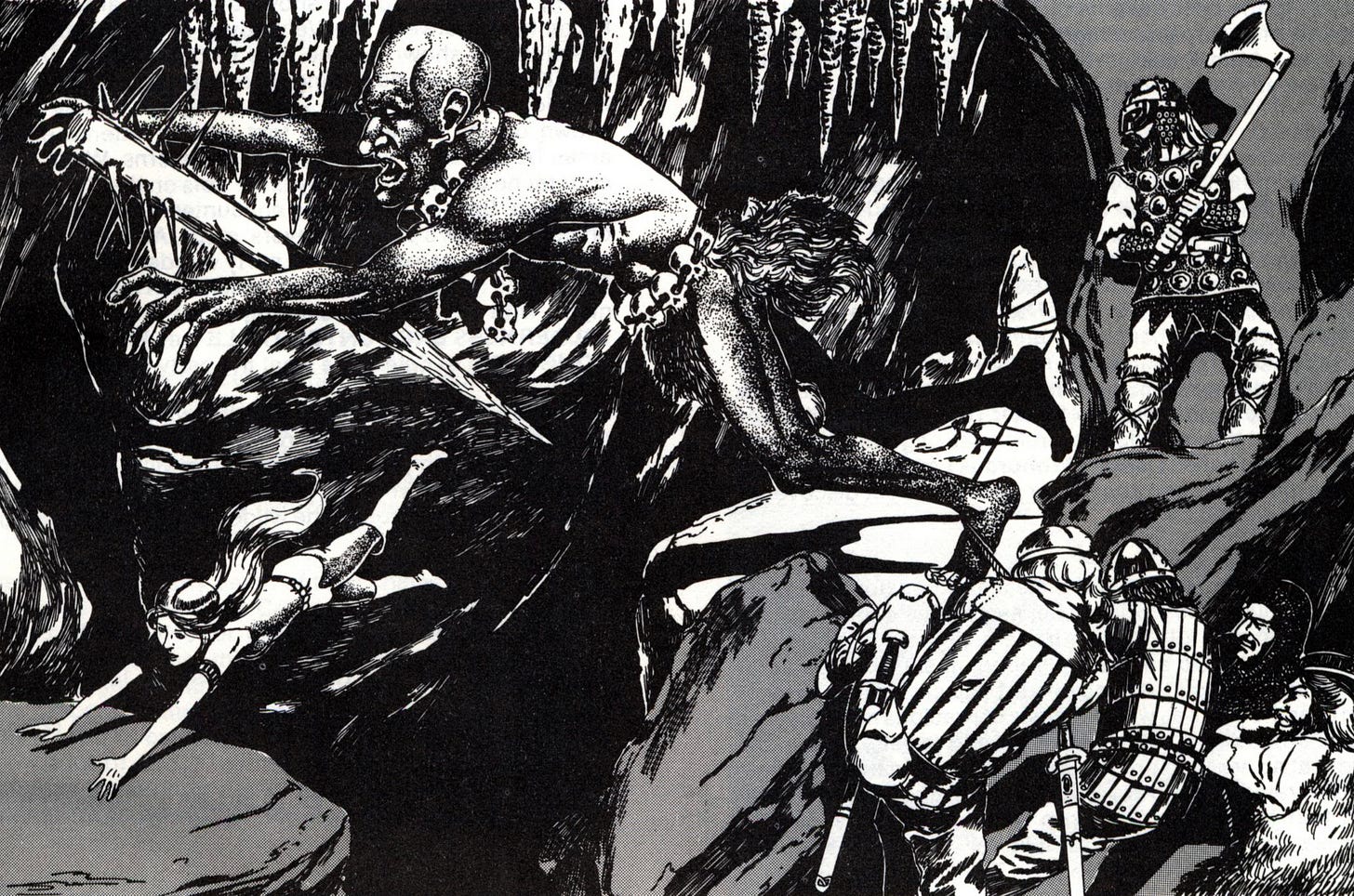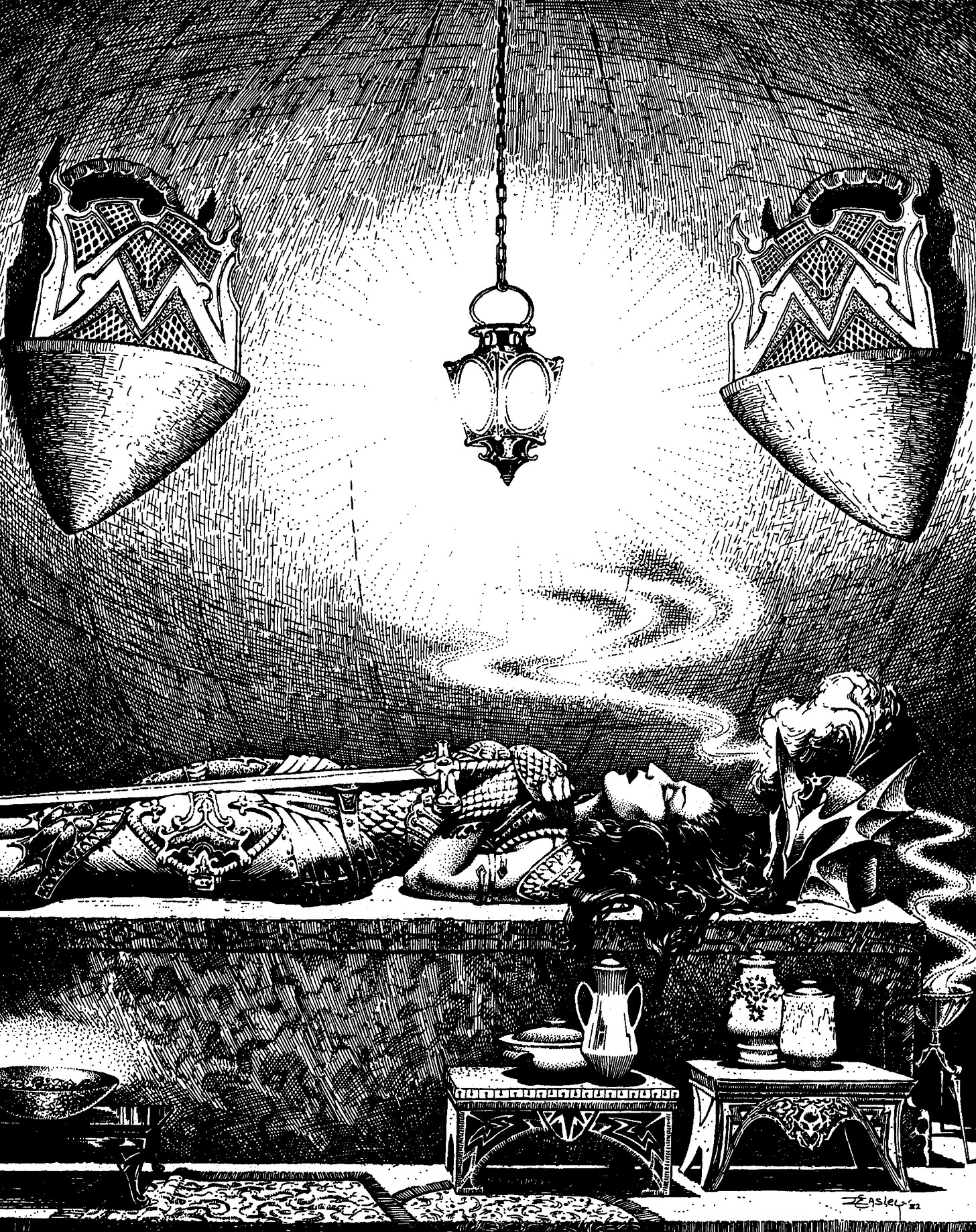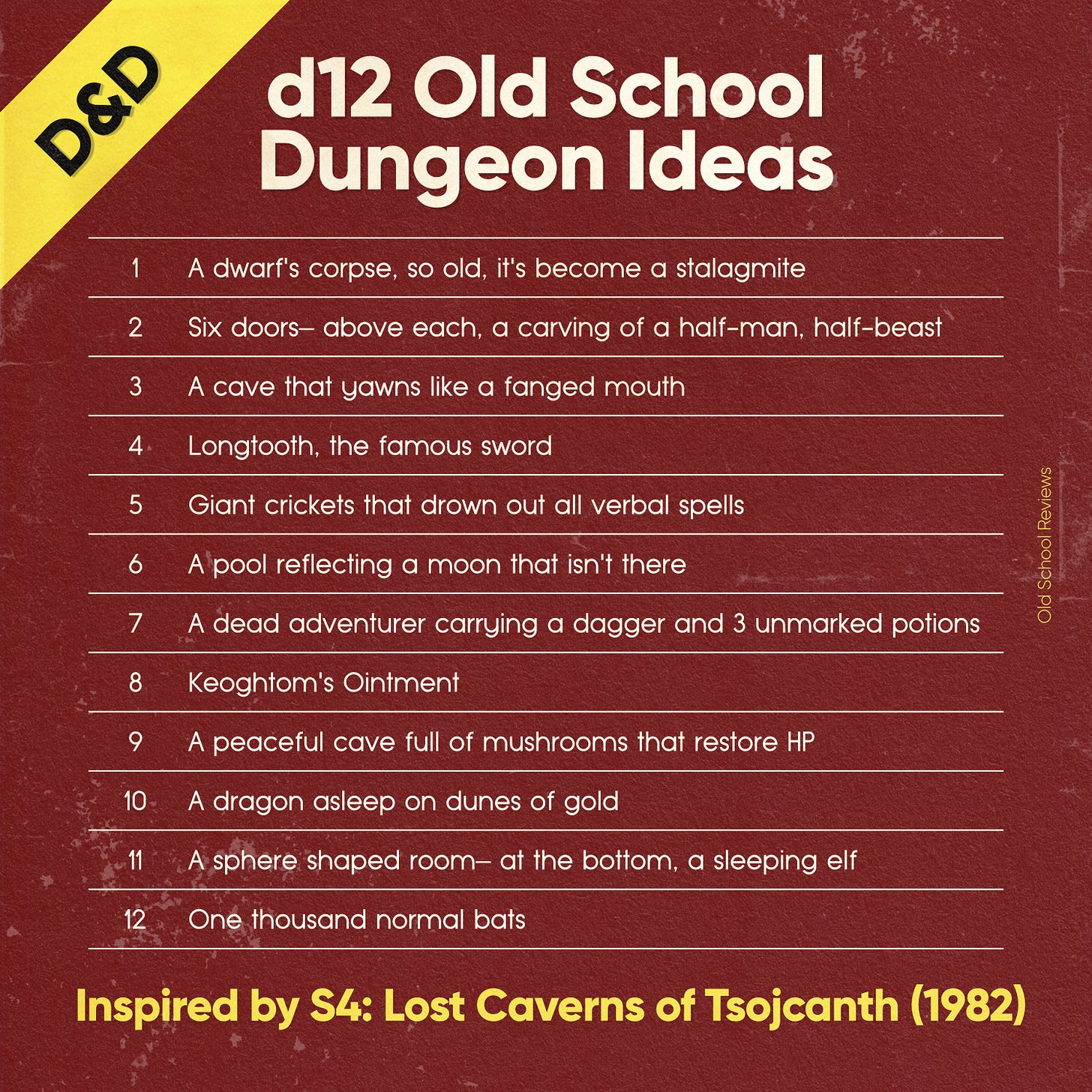S4: The Lost Caverns of Tsojcanth | Old School Review
A hexcrawl, treasure-eating elementals, and a boss battle against... Sleeping Beauty?
“In the Yatil Mountains there is rumored to be a treasure of such fame that scores of adventurers have perished in search of it. Find the perilous Lost Caverns of Tsojcanth and you may gain the hidden wealth of the long-dead arch-mage— if you live!”
A (Very) Brief Introduction
Published in 1982, the Lost Caverns of Tsojcanth is the fourth module in the famous “S” series that includes iconic adventures Tomb of Horrors, White Plume Mountain, and Expedition to the Barrier Peaks. Gary Gygax wrote much of the content in 1976, where he ran it as a tournament module at WinterCon. 1976! Remember that. It’ll be important later.
As always, this review aims to mine a module’s best ideas and give them to you for inspiration. To support Old School Reviews, you might:
Email someone this review.
Buy the module via the affiliate link.
Get a paid subscription ($30 for the year, the cheapest Substack allows).
OK, let’s get into it!
11 Old School Ideas Worth Stealing
1. A Full-On Hexcrawl
For a dungeon module, this adventure has a surprising start: an overland hexcrawl, big enough to last several sessions. But what’s more surprising is just how good it is. As the Players search for the Caverns (they are lost, after all) they might encounter:
A Border Patrol searching for brigands.
Giant snakes with “furry hides” for which mountaineers will pay top dollar.
Local tribesmen that can be bribed to scout, porter, or raid.
A wyvern roost with a clutch of valuable eggs.
Renegade orcs “capturing hippogriffs” to sell to the ultra-rich.
The highlight is the dynamism of the NPCs. No one is simply a friend or foe. Everyone— from the border patrol to the local tribesmen— offers opportunities for information, aid, or conflict: the fledgling hippogriffs can be tamed and ridden in one year’s time; the border patrol might mistake the Party for bandits; hell, even the blue dragon lets the Players pass for 1000 gold and “at least one horse for a snack”.
2. Monsters That Eat Treasure
Xorn— visitors from the Plane of Earth— are in the Caverns to “do a bit of gourmet dining”, which is Xorn-speak for “devouring crystal rock formations”. Insatiable, they will demand metal from the Party. Naturally, the Players can lie— but the Xorn can smell precious metal and will attack to get their dessert. They definitely have posh English accents. And they definitely explode into slobbering monstrosities when denied gold.
3. Subterranean Rivers
Water encounters are always welcome in a dungeon, and Tsojcanth offers several:
A magic boat that can travel upstream, “stand motionless in even the swiftest current”, and shrink at the sound of a command word.
A giant snapping turtle, asleep at the bottom of a subterranean lake. If it surfaces, there’s a chance it capsizes the Players’ boat.
A thundering waterfall. “It is suggested that any party so careless and foolish as to pass unwillingly over the falls… be considered casualties of the Lost Caverns of Tsojcanth.”
4. Stalagmites Made from Human Corpses
The chilling Cavern of Corpses is fit for a horror game. The circular room is lined with calcified corpses standing on each others shoulders. The bodies— stony under decades of mineral deposits— loom from the walls like melted gargoyles.
Elsewhere, a forest of fungus and stalagmites becomes “a most phantasmagoric series of shapes: here a spired deposit could be an efreet castle, there a pocked toadstool looking like some hunched monster”, brought to life by the flickering of the Players’ torches.
5. A Legendary Troglodyte
A typical fight with a bunch of troglodytes takes an unexpected turn when their “Champion” joins the battle:
When the “great” leader appears… the other trogs will pause for one round while their hero steps into the fray, croaks its horrible challenge, and wades into the enemy. Immediately upon doing so… a horde of troglodytes [pours into the cave!]”
If the Players stick around, they’ll soon discover the Champion wields a Sword of Illusions.
6. An Eerie Sculpture Garden
A small dead-end cave is filled with “finely done sculptures of small animals— rats, bats, lizards” and the shattered bits of similar sculptures. This is not a treasure trove of art; it’s the den of two cockatrices, nested mates surrounded by the victims of their petrifying gaze.
7. The Most Chaotic Encounter Ever
A couple ape-like demons called bar-lgura use illusions to create an unforgettable combat scene:
“If the combat is turning against them, the bar-lgura will… create a spectral force illusion of a dozen type I demons flying into the cavern and swarming towards the party to attack. During the distraction, the bar-Igura will… assume the forms of mountains dwarves and pretend to enter the cavern to help the Party [fight the demons].”
8. Hilarious, Half-Assed DM Instructions
One room teleports the Players into a canyon with a bunch of angry centaurs. Naturally, there’s a specific, annoying way to return to the dungeon that involves horseshoes. However, should the Players choose not to escape, the module provides this helpful note:
“If the party chooses to explore this alternate dimension, the DM must create adventures in this area. The centaurs’ world is similar to the world of Greek Mythology.”
There we go. Now that I’ve derailed the entire campaign, the DM can sort it out!
9. Bizarre Dwarves
In the dungeon’s first level, there’s a cave with a mineshaft. If a light is shown within, the Players will discover a group of pech— “skinny, dwarf-sized creatures”— hewing a staircase into the rock. “Douse that cursed light, STUPID” they hiss. If the Players comply, the pech are willing allies.
10. A Surprisingly Well-Developed Hill Giant
A hill giant wearing an ivory necklace and giant weasel pelt keeps a pet rock (actually a massive horned rhinoceros beetle) on a thick iron chain. It farms mushrooms for food and raises shriekers to warn of intruders. On Tuesdays, he plays bridge. (Just kidding.)
11. A Boss Battle Against… Sleeping Beauty?
At the bottom of a smooth, sphere-shaped room likes a woman asleep on an alabaster slab. Her skin is pale, lips red, hair black. She is dressed in golden platemail and a bastard sword lies between her breasts.
Step lightly, adventurer… this sleeping maiden is a vampire, Iggwilv’s daughter, and the final guardian of the arch-mage’s wealth. She is utterly ruthless, dealing d64 (!) damage with her vampiric attacks, summoning rats, and draining levels— an old school fate worse than death.
Should the Players defeat her, they may discover a legendary treasure trove that includes the first-ever appearance of Iggwilv’s Demonomicon, an artifact that has persisted in D&D lore for four decades.
So, should you Play, Read, or Skip this module?
Skip… but hold on!
Tsojcanth is a boilerplate dungeon: darkness, fungus, ambushing foes, save vs. something horrible. It disappoints because it sticks so closely to the genre’s conventions. But remember: this thing was written in 1976. The genre didn’t have any conventions. Gygax and company were creating it, and that nascent genre— what gamers would someday call a “dungeon crawler”— is archived here in one of its earliest forms.
So— does module S4 have a premise that doesn’t really have anything to do with the dungeon itself? Sure. Have better dungeons been made in the 47 years since this was published? Absolutely. But those dungeons exist because this dungeon exists. And that matters.










